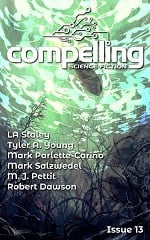 Compelling Science Fiction #13, Summer 2019
Compelling Science Fiction #13, Summer 2019
“Steps in the Other Room” by LA Staley
Reviewed by Geoff Houghton
The most notable characteristic about the summer 2019 issue of Compelling SF is the resemblance to the pulp magazines of the Golden Age of SF. The majority of the stories selected by the editors are classical SF and explore our human responses to technological change and alien or otherworldly challenges.
The first offering is “Steps in the Other Room” by LA Staley. Police Officer Queensbury and his AI partner (the autonomous car Ace) dwell in a technologically advanced and civilised near-future North America (We are specifically informed that the date is 1st August 2064).
They are called to the suburban home of an elderly lady. She demands assistance from the police because, four years after her husband’s death, he has suddenly ceased to haunt the house. The subsequent investigation by the police officer and his AI partner uncover the reality of the situation.
The writing style is reminiscent of the heyday of pulp SF magazines with characterisation taking second place to a clever little plot. This is not a ghost story but solid, old-style SF. To say more would only act as a spoiler.
The second offering is “Sasha Red” by Tyler A. Young. It is set in the inner solar system about a century or so from today. Earth has a benign but rather hapless trans-national government with no ability to deal with the crisis caused by a failing Mars Colony. Thousands of ill-equipped and mainly unwanted refugees flee Mars in dangerously inadequate spacecraft. The feeble Earth Government response is to inadequately fund a rescue service for those refugees in genuine peril. This story follows the three-person crew of such a ship through a difficult mission. Their task is made harder still by the bureaucratic rules imposed by an Earth Government that is hopelessly divided in how to respond to the refugee crisis. There are no true villains in this splendidly old-style space-based SF story but there are some unexpected and unlikely heroes.
The third offering is “Bodybit” by Mark Parlette-Carino. This provoking story is set in a near-future world. Social media has extended to sharing detailed physiological statistics, including precise parameters of sexual performance and sexual honesty, via the “Bodybit” of the title. Once again the editors have selected classical SF where the world is entirely recognisable except for one futuristic factor and the impact of that single factor on society is the heart and purpose of the story.
The “Bodybit” is plainly the successor to the “Fitbit” of today and the author cleverly explores the sociological impact of sharing such intimate details. He predicts the emergence of a sub-culture of competitive sexual athletes who live for improvement in their “stats,” but he is upbeat about the ability of ordinary citizens to deal with and find benefit from the new openness that might ensue when the truth about an individual’s mood, veracity and temper can be read from open sources.
Fourth in Compelling SF #13 is “What We Remember” by Mark Salzwedel. This is a “First-Contact” story with a twist. An exploratory team is in trouble on an alien world. The rescue team has to first puzzle out what has happened to them and secondly to understand why. Then they must develop a form of communication with a sentient life-form that shares so few common points of reference that no ordinary human communication channel will suffice.
Next is “Love and Brooding” by M.J. Pettit. This is a first-person account of the birth and childhood (not necessarily occurring in that traditional order) of a water-dwelling sentient lifeform. The action of the story occurs on a planet that may well be a ruined Earth of the far distant future.
The narrator “Pax” shares the deeply alien perspectives of an intelligent fry growing to adulthood amidst the dangers of the river, not least of which are his own siblings and father. It is difficult to write truly alien dialogue in the first person, but the main arc of the story succeeds in that tricky task. The author then adds further complexity with hints of a deeper purpose to the life-cycle of these alien creatures and a rather metaphysical relationship between two of the fry of this spawning.
The last story is “Steadies” by Robert Dawson. This is set in an unspecified first-world country in the very near future. The narrator is a female General Practitioner. The premise is the discovery that a fictional statin-type anti-cholesterol agent has an unexpected secondary effect. The drug stabilises long-term relationships and significantly decreases the incidence of their failure. The author explores the expected and unexpected impacts of this fictional product on society via the actions and observations of his protagonist. The initial premise may be fairly unlikely given the complex nature of human relationships. However, one impossible event is always allowed in all speculative SF of this type. In this case, once that is accepted as a premise then the author’s take on the impact of this drug on society is coherent and fascinating.
Geoff Houghton lives in a leafy village in rural England. He is a retired Healthcare Professional with a love of SF and a jackdaw-like appetite for gibbets of medical, scientific and historical knowledge.